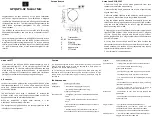
Trouble Shooting
Page 25
out of range, there may exist some background radio interference in your environment preventing a good link (including
another P1 Transmitter being used by another photographer near by), or one of your units may be damaged. Move to
another location and try it again to eliminate the possibility of some source of radio interference operating near to you.
3. When a good link is established (the Link LED lights and remains lit solid on the P1 Receiver), tap the Link Button on
the P1 Transmitter one time quickly. This should cause the Link LED on the P1 Transmitter to strobe. It will also send a
test message meeting the same timing requirements of an actual flash trigger event to all active P1 Receivers. If this
message is received correctly, they will blink both of their LED’s together several times.
This indicates a good radio connection exists and the units are clearly communicating with speed an accuracy that
should allow normal operation.
4. Install your P1 Transmitter on top of your Master Flash or IR Commander as described in the Installation Instructions
section of this manual. When you take a shot, the Link LED on the P1 Transmitter should strobe briefly following the
shot. This indicates the magnetic sensor on the P1 Transmitter is picking up a signal from your Master Flash or IR
Commander. It does not necessarily mean the signal is complete or correct, simply that a signal is being received.
If the Link LED of the P1 Transmitter does not strobe when shooting, re-check your installation and that the batteries in
your P1 Transmitter are good, as well as checking the batteries in your IR Commander.
You may try adjusting the placement of the P1 Transmitter on top of your Maser device slightly, though much
adjustment should not be required. Even if the Link LED on the P1 Transmitter does strobe after a shot, it is possible it
may not be picking up the complete signal from your Master Flash or IR Commander. Again, this is rare but possible.
The sensor (the “bead” hanging on the side of the P1 Transmitter) should be 1/2” to 1” above the plastic surface of your
flash, and should be placed rear of the front edge of the flash 1/2” to 1”. Moving this sensor closer to the flash lens
(where the light comes out) may actually degrade performance. The magnetic signal is strongest and most consistent a
bit further back from the flash lens and a short distance above the plastic exterior of the flash.
5. Check the placement of the nylon bead at the end of the optic tube on the P1 Receiver. Insure it is placed over the
infrared sensor of your flash as per the Installation Instructions in this manual. It should NOT be placed over the red
plastic piece on your slave flash - this is not the infrared sensor. On the SpeedLite 550EX used as a slave note the infrared
sensor is not centered on the black window, it’s in the lower right corner. See Fig XX in this manual.
Also check how the optic is inserted into the sleeve on the side of the P1 Receiver.
6. Make sure there is no excessive bend in the optic tube extending away from the P1 Receiver. A bend any tighter than
what would wrap around your finger should be avoided. Too tight of a radius and light may not travel through the tube
as efficiently as designed and could lead to mis-fires.






































